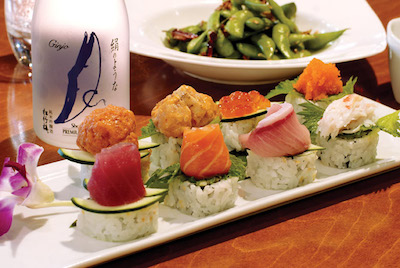How David Lee, owner of a growing sushi chain went from broke to big fish.
by James Lee
The story of the industrious immigrant who lifts himself up by his bootstraps has been played out countless times in this country. But also a part of the American ethos is the notion that a person can reinvent himself in this land of opportunity. From Oprah Winfrey to Steve Jobs, who was once dismissed from the company he co-founded only to return and make Apple a technology titan, our nation has witnessed individuals who found success—and admiration—after a transformative experience.
Enter a former mechanical engineer with such a passion for Japanese food that he decided to ditch his comfortable middle-class life and plunge into the turbulent world of the restaurant business. Meet David Lee.
Over 20 years ago, Lee’s first marriage was coming to an end. “The divorce really helped to make my decision. I didn’t have a frickin’ reason to stay an engineer because I had to start my new life,” he says. So, in April 1991, he chose to open a sushi restaurant with the name Kabuki. His father ran a Japanese eatery back in Korea for about 20 years, although Lee never worked in it. And this was the early 1990s, when sushi was swimming nowhere near the culinary mainstream it wades in now.
 But Lee, who immigrated to Southern California in 1982 to attend engineering school, had been taking hospitality management courses at Cal Poly Pomona. “When I studied marketing and economics and accounting, it was all really new for me. And it was fun.” He also studied at the school of Benihana. “Whenever there’s a special, there’s a one-hour wait. I’m thinking, ‘This is a tremendous business.’”
But Lee, who immigrated to Southern California in 1982 to attend engineering school, had been taking hospitality management courses at Cal Poly Pomona. “When I studied marketing and economics and accounting, it was all really new for me. And it was fun.” He also studied at the school of Benihana. “Whenever there’s a special, there’s a one-hour wait. I’m thinking, ‘This is a tremendous business.’”
His first restaurant, located in Pasadena, featured a traditional Japanese setting, with silk tablecloths and the staff wearing kimonos. It maintained that upscale milieu sushi held at the time. But that business plan wasn’t panning out. And then, in the wake of the 1992 L.A. riots, people weren’t going out to eat. At one point, Lee couldn’t make payroll, was six months behind on his rent, and, with his utilities four months unpaid, his electricity was turned off. He operated by only candlelight that night.
“After [the] riots, I just reorganized and restructured the restaurant. Let’s just take off all the kimonos. Let my servers wear a nice Hawaiian shirt and my chef a T-shirt. I cut down the menu prices,” says Lee. “Let’s just start from scratch.” It worked.
• • •
Lee is sitting at a table in his Hollywood location—one of 14 Kabuki restaurants now operating in three states 20 years after the first opened—having his hair fussed over by a few servers who want their boss to look sharp for some magazine photos. With wavy locks and stylish eyeglasses, Lee cuts the figure of a film director, which was his childhood dream job. Now, to Lee, each new restaurant is the equivalent of debuting a new movie.
“I love the design part—the interior design, the menu design,[food] presentation,” says Lee. And like the Japanese theatrical form from which Kabuki gets its name, running a restaurant is akin to putting on a performance for the customer. “This is art,” says Lee. “At the same time, it’s a small manufacturing business. We buy raw materials, and we manufacture these items.”
To some, the food might be too mass produced, with Japanese flavors being sacrificed to American palates. Kabuki, however, according to Yuji Matsumoto, a former president of the California Sushi Academy, occupies a middle ground, even playing a role in educating people about Japanese food culture. “With sushi, we need to have California rolls and spicy tuna rolls, and then people will go to the next step and try uni and monkfish liver,” says Matsumoto, who’s been Kabuki’s master sake sommelier, a distinction earned through a certification process, for the last three years.
There are other aspects about Kabuki that might annoy purists. “A lot of high-end Japanese sake sommeliers, they don’t like cocktails. But I have no hesitation to make cocktails from sake,” says Matsumoto. He’s also devising sake pairings to go with specific dishes. “I want Japanese food to feel very approachable,” says Lee. “It is not exotic anymore. Let everybody enjoy this food.”
Though some of Lee’s favorite items have gotten axed from the menu for being “too authentic,” he has managed to introduce an izakaya menu—Japanese bar food—which is now available at the Hollywood restaurant and includes items like natto (fermented bean paste).
Kabuki now employs about a thousand people. Eleven locations are scattered throughout Southern California, with two in the Phoenix area and one in Las Vegas. Even with these trappings of success, Lee doesn’t feel “successful”—yet. He aspires for restaurant and sales numbers that echo the figures of Cheesecake Factory and P.F. Chang’s. Plus, he has a new restaurant concept coming soon of which he won’t reveal any details.
“Our vision is to introduce Japanese food to more people in the States,” says Lee, hinting of his expansion plans. And then he utters words you might not expect to hear from a restaurant owner: “We’re still hungry.”







